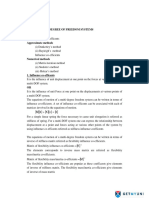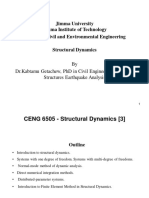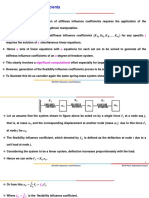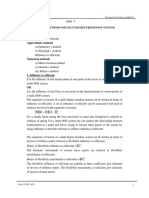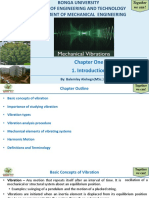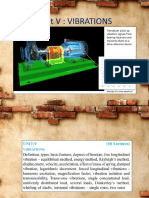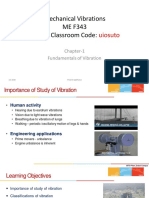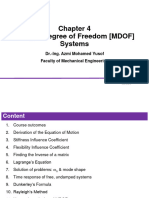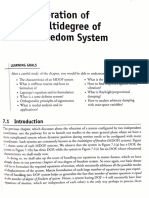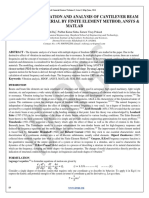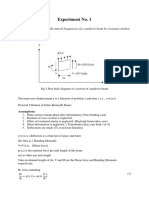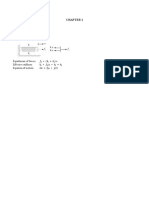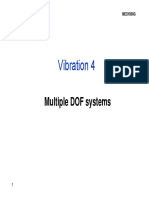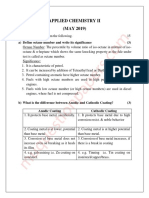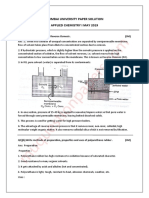0 ratings0% found this document useful (0 votes) 35 views10 pagesFEM - Module
Copyright
© © All Rights Reserved
We take content rights seriously. If you suspect this is your content,
claim it here.
Available Formats
Download as PDF or read online on Scribd
; todinle $
HAPTER 11
Lee
“
ptroduction to the Finite‘,
slement Method eae
Gn Aw 8y k, 2 0 ts *
Sar Oe ag © bere, ky Fly o & tt
Sy Gee oy S hae, wasn
2
ve discussing the finite element method, we determine the stiffness matrix of sim
by considering th ple frame
cqatures bY cor em the structure as an assemblage of structural elements. With the forces and
gonentsat the ends of the elements known from structural theory, the joints between the elements are
saiched for compatibility of displacements and the forces and moments at the joints are established
‘imposing the condition of equilibrium,
Inthe finite element method, the
me procedure is followed, but in a more systematic way for
computer calculation. Although s ith few elements can be analyzed simply by the method
valined initially, the “bookkeeping” for a large structure of many elements would soon overcome the
ssence of the analyst. In the finite element method, element coordinates and forces are transformed
‘oglabal coordinates and the stiffness matrix of the entire structure Is presented in a global system
efcommon orientation.
The accuracy obtainable from the finite element method depends on being able to duplicate the
sation mode shapes. Using only one finite element bets
rsults for the first lowest mode because the sta deflection curve is a good approximation to the
bast dynamic mode shape. For higher mod ‘everal elements are necessary between structural
sit, This leads to large matrices for which a computer 18 essential in solving for the eigenvalues
‘sdeigenvectors of the system.
This chapter introduces the reader 10 the basie ideas of the finite clement method and also
‘cludes the development of the corresponding mass matrix to complete the equations of motion for
cents for the axial and bear elements are di ed here.
d to other (exts. Qs
ae
t ey Deg
MA FLEXIBILITY INFLUENCE COEFFICIENTS
ad either in terms of the stiffness or the flexibility
n for the normal mode vibration in terms of the
uetures
con structural joints or comers gives good
Sedynamic problem. Only structural elem
Fore treatment of plates and shells, the reader Is referre
Tie castic behavior of a system can be exPpret
® far, we have written the equations of MOOD
itn a)
ol pK DIXD = Oh
i) hepato r) Collen
hey E \ feted ee
> Cm KETO >
Scanned with CamScanner
(bid�-SEICI+AW bd o
314 Theory of Vibration with Applications (-Weh &) CT =o
sed in terms of the displacement
Fe ke
Inthe stiffness formutat the force is expr ;
4~ 364 © RP = IKI a
The displacement is here Written in opm,
(7 FRambnlit om
ba
2 ae eee
Alpen mr wie
FS C0 kya) |x Ge tar) ny
ily determined by remultplyng Fy.
CF
ly
thy
The flexibility is the inverse of the stiflness.
The equation of motion in terms of the lexibility ise
by AT! = fal:
qe
(<0? [al[M] + D(X) = (0) (Mtg
ios) Dien & '® = 1 unit matrix,
The choice as 10 which approach to adopt depends on the problem. Some problems a
ued on the
inverse propei
AL vibration.
&
ai Ire mote.
s of stiffness, and for others, the flexibility approach is desirable
'y of one or the other is an important concept that is used throughout the theory of.
easily
The flexibility matrix writter
terms of its coefficients ay is
!
ot we ¥
xy a an a3 fi
an M2 P=] a a2 a3 h (ILLS)
x3 a1 432° 433 A
The flesibiliy influence coefficient ay is defined as the displacement at i due to a unit force
applied at j with all other forces equal to zero. Thus, the first column of the foregoing matix
renpesents the displacements corresponding to fi = 1 and fs = fs = 0. The second column equal
to the displacements for fs = | and fj 0, and so on.
Example 11.1.1
x
Determine the fesibility matrix for the three-spring system of Fig, WAL
5
Gu , bo bw Lewin or
Ma .
a
~ 4 yoru
Vm FIGURE 11.1.1,
Solution By applying a unit force fj = 1 at (1) with fy = = 0, the displace;
for the frst column of the flexibility matrix 2 fh = O.the displacements, x}.
Gu Ge ayy " Mh 0 0
Ay Sue ayy aps vty 00
xy ky 0 0
Gat Ou ous '
Here springs Xp and k3 are unstretche
and are displaced e
Next, apply forces fj = 0, fy Moo
Vea, = 0 toa ih ation (4)
" ok a 0 rn
menace, [beans]
. ost oflo ;
Gre +r st ~ te! Scanned with CamScanner�introduc
Vion to the Finite Flement Method 315
sane te Hl FACES HIMSA Anaph
ws nile Manner, for MeoueH Ay and ky, nd
109 A= fy Wand sp, Iwek 14) 1s aistretched ) ,
have wvyet Hat
" oo pM Ie
2 vo jo ‘3
4 “
oo ee da
complete flexibility matrix is
The comp y matt mow he sum ot het
“
1
“1 i
(3).
My iu
ei
swe the symmetry of the mattix about the diagon:
a
fample 11.1.2 ww
taternine the lexibility matrix for the system shown in Fig, 11.2 (3s oo) es a3
DUNE a? 4
= wer m2, rs q!
ke Ton sy
< 2k k
wr? by | am m wf on
—*, —% —x,
Gaz dade 3 FIGURE 11.1.2. Onteasa, 4 k
Bw Ww 2 =. are “2k
4212042 tA Out ag
Solution We have here ky = 2k, k2 and kj = k, and the flexibility matrix from, Example 11.1.1 becomes
sft =
mee shar 2+] 05 05 05 — ve OS U
Bee 2 gallos 1s 15 (Ce,
Klos 1s 25 aff or Ut ey
Shs 2
ay 2
Sample 11.1.3
Daermine the flexibility influence coefficients for stations (1),
own in Fig. 11.1.3,
(2), and (3) of the uniform cantilever beam.
an be determinied by placing unit loads at (1), (2), and (3) as shown,
ig the arca moment method,! the deflection at the various
ion in question. For example, the value of
Solution The influence coefficients ¢ an
“4 calculatin; 1 these points. By usi
1g the deflections at :
“tions is equal to the moment of the M. EI area about the posit
215 ayy is found from Fig, 1.1.3 as follows:
a2 = Fy
Scanned with CamScanner�ications
316 Theory of Vibration with Applicatic
ae ay ay
FIGURE 11.1.3.
The other values (determined as before) are
an =a
any =a
413 = 431
and the symmetry about the diagonal should be noted,
Example 11.1.4
‘The flexibility influence coetlicients can be used to set
bearing at one end with a force P anda moment Af
The deflection and stope at the free
up the equations of a flexible shalt supported by a
athe other end,
las shown in Fig. 114.
end is
UP + ayM
ul
O=ayP + ani
FIGURE 11.1.4,
Scanned with CamScanner�; ee
Introd
| ction to the Finite Element Method 317
|
|
FIGURE 11.1.5.
Demonstration gyroscope.
(Courtesy of UCSB Mechanical
Engineering Undergraduate
Laboratory.)
pe expressed by the matrix equation
y]_fan af P >
faj-Ea alte] ain
uence coefficients in this equation are
(Ls)
B
a=
3EI
m2 =a
a
ing the problem ofthe gyroscopic whirl
‘and A/ in this ease would be replaced
Troment of the spinning wheel, By including the flexibility
1 problem can be examined (see Prob. > 9).
spe in gimbals. The mass distribution of the wheel
jon other than that of the symmettic wheel
ant M/ shown in Fig. HL.
d offer a basis for sol
‘The equation presented here coul
an overhanging shaft. P
spinning wheel fixed to the end of
he inertia force and the gyroscopic
‘be supporting bearing, a still more genera
Figure 11.1.5 shows @ demonstration gyFoscePe
“stable to obtain general moment of inertla configar
in the simple inertia force P and the gyroscope momel
co Aarweh Rupa ure,
and
1.
12 RECIPROCITY THEOREM
system, ey = > FO" the proof ofthis theorem, we
ing is # followed by j andl then by
re the onde i
he work d rendent of the onder of
‘ciprocity theorem states that 1" eof hal
Jone is indeps
de
wer the work done by forces fi and fy WOE
ize
ou
Teverse,
ing Reciprocity results when We
1p?
1/2 applyin a fj tiee work done by f 18 eu However,
_ By applying f,, he work done is Bea BY om a Ft A bc ai eer tole
J the addition’ wth €
J a
ice further eae ‘yf
a Ziv Ss rf
canned with CamScanrfer�Gol y
—
318 Theory of Vibration with Applications
hy A wn
total work done is 3 1
i Peay + fr ain + aiihhi
, ® the total work done is
i the order of loading, in whieh ease the (08
fe now reverse the order of loading
4 jo a " Lea t we it abl Apa hy J
Because the work doni
athe two cases must be equal we find that
cis (ot ay ay = a
Example 11.2.1
Figure 11.2.1 showsan overhanging beam with P first applied at | and then at 2, In Fig. 11.2.1(a), he
atdis
dees,
yy = ay1P
In Fig, 11.2.1(b), the deflection at 1 is
yr =a
Because a2 = «24,¥1 will equal y2, Le. fora linear system, the deflection at 2, due to 2 load at I seq
the deflection at 1 when the same load is applied at 2
FIGURE 11.2.1.
11.3 STIFFNESS INFLUENCE COEFFICIENTS
The stfiness matrix writen in terms of the influence coefficients f
ents ky is
fi :
fh }= ' :
h 5
The elements of the stiffness
I matrix have the
0, the forees at 1, 2, and 3 that are a
following interpretation. Ifx, = 1.080875
are ky, ky, and 3) in the
e e a I
first cota te4 to maintain this displacement according 1 Fie
Column. Similarly, the forces ff, and fs required to "="
Scanned with CamScanner�Introduction to the Finite Element Method 319
configuration 1 = 0.2 = 1.0, and x3 = 0 are ki2.kr2, and fy2 inthe second column
eo efor establishing the stiffness elements of any column is to set the displacement
sje ge at column to unity with all other displacements equal to zero and measure the
re ont at each station.
i
ot
en
apie tt 3.1
shows
(3
re
OF system. Determine the stffiess matrix and write its equation of mi
m Lv] m, mM Mm; ww}
t,, ty, ty,
FIGURE 11.3.1.
pepe with xy = Landxy = x3 = 0. The forces are now
h
fe
Forte last colurnn of &’, let x3 = 1 and xy = x = 0. The forces are
fakth=bs
‘Testtess marx can now be written as
(tk) ke 0
K ky (in ths) 3
0. hs is tha)
Riis,
‘station of motion becomes
0 x fi
m0 0 % ath) kh Is m pak
Om % b+ -h (ath) -8 a
[" m2 a i | + [ - ie wrk dls h
© scanned with OKEN Scanner�|
__ SEVERAL DEGREES OF FREEDOM SYSTEM | 323
If r=s then Eqn. (6.5.8) becomes,
(XY IMIIX],=M, (say) en(6.5.11)
and (XY, [KX], = K, (say) (6.5.12)
e
® M, and K, are referred as the generalized mass and generalized stiffness matrices
respectively.
® M, and K, are actually (X} matrices and above equations are used only to determine
the single elements of these matrices.
For degree of freedom system the orthogonality principle is
es my; (x;), (%)), = (6.5.13)
when, r+ sit is principal mode of vibration of the system.
‘The expressions obtained in Eqn. (6.5.9, (6.5.10) and (6.5.13) are the mathematical conditions
of orthogonality of the normal modes. However, in certain cases of 2-degree and 3-degree freedom
systems, the normal modes will be physically to be perpendicular to one another.
5, m, {(x;),P =M, 5.14)
‘The orthogonality principle may be considered to be a fundamental property of vibrating
systems having two or more degrees of freedom. Its importance lies in practical calculations of
natural frequencies.
6.6 MATRIX ITERATION METHOD
With the help ofthis method the natural frequencies and corresponding mode shapes are determined. Use of
influence coefficients i made in the analysis. The method can best be understood by soloing the problem of
Fig, 6.5 by matrix iteration method. MAL, 2008 ; P.U. 85)
SOLUTION. The equations for the above system in terms of
influence coefficients can be written as
xy =a 4inx, OF + ayy2mx, OF + a,,m, o
4m
xy = ayy Ax, 0 + yy2mxy WF + Ayymxy al
2 2 2
y= Ay, Ax, oF + agy2mrxy O + AgyMIxy
Influence coefficients are
= My
2m
= ay => fl
3k
Fig, 6.5
ie
, ofan
ER . Scanned with CamScanner�324] | MECHANICAL VIBRATIONS
Substituting these terms into above equations, we get
Am. 2 8M gd Am, oo
4m m , xy =A x, 0? 4 Bx, ot 4 My,
x=e— + omy, wo tty ot ; a 1 3
Te ar xe 3k 3k 3k
Am 4 by, 7m
xo? + 2 xy?
Be 1 ta 2 GES
X=
This can be written in matrix form as
Fs 42 1)]fa,
5 ; 1
ape Gea 4 X
%y 48 7]\(x;
To start with the iteration process, let us assume
x 1
Xp p= y2 a Xd o
x5 3
@ First iteration
% 2 f421)7{1 u 1
om @
oy f= SM gg a flab o2'm| 99 |-2'mayloor
x Be 5 3k (1)
x 48 7|(3 41 3.73,
Now assume
x 1
x, $={291
x3} [3.73
@ Second iteration
x > f421)7[ 1 > [1355 1
X Se 48 291 Sere 42.2 |= 2 13,55)/3.11
xy 48 7}(373 5339 3.94
421){1 1
48 4]/311 (14.16) 3.15
48 7]\[394 3.98
4217/1 14.28 1
48 4 }) 315} 2 M4512 |- 2°" a4 2813.15
487} {398 : 3.99,
Scanned with CamScanner�SEVERAL DEGREES OF FREEDOM SYSTEM
The ratio obtained in the fourth iteration is very close to the initial value, 5°
1 : 1
3.15 } = rt) 3.15
3.99 3.99
or ue = mo=1 > o 3k
14.28 m
1
K rad/ sec, mode shape } 3.16
4
3_k
= |< = 458
OV T428
Calculation of Higher Modes by Orthogonality Principle
It is known that the directional shape of system can be represented by the linear supér-
position of its various normal modes. For the case of 3-degree of freedom system, we can write
(XJ=C, + G a + Cs 5
where C,, Cy and C; are constants.
i)
a
and {x}=] x, } which is assumed deflection of the system.
x3
Second Mode
Firstly we introduce the orthogonality relationship,
(xy, (MIX), =0 where r¢s
Pre multiplying Eqn. (i) by (X}, (MI
(XH, [MIX = Cy (1 (MIG), + Co ON IMI). + Cy (Xh (M13
OX), (MIE =C, 20 (MI), +0 (as per Orthogonality principle)
In order to obtain the second mode, we will eliminate the first normal mode in Eqn. (i) by
putting C, =0, we get
(x), (MI {X}=0
which can also be written as :
m 0 0 Tfx
%,%3,] 0 m 0 |} x, |=0
0 0 mlx
dsm 1 +a) Maxe +5), mMyxs =O ii)
3
or 2, (x,), mx, =0
Scanned with CamScanner





